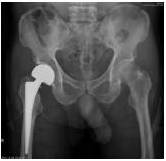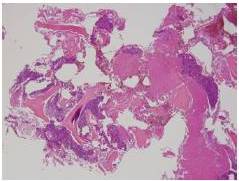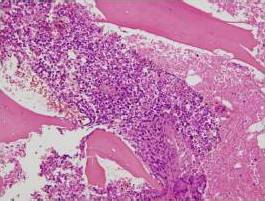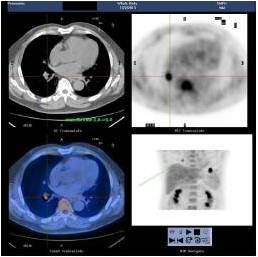Discussion
Primary lymphoma of bone is rare, and most lymphomas that involve bone are metastatic from lymph node. In this case, we demonstrated an atypical presentation of intraosseous lymphoma–traumatic femoral neck fracture in a patient. He did not present with the most common symptoms of bone lymphoma–bone pain or a mass, and his radiography of pelvis disclosed no significant bony tumor lesion, such as osteolytic, osteoblastic, and osteosclerotic signs. The final diagnosis was confirmed after pathological examinations of surgical specimens. It reminds us that the clinical manifestations of bone lymphoma are protean, even in the clinical condition of traumatic fracture.
In the recent study (Qureshi et al. 2010) that reviews a total of 60 cases of bone lymphoma during the period from 1998 to 2008, the most common site of involvement was femur (28.3%), followed by hip (16.6%) and humerus (10%). In addition, iliac bone and spine were ever reported to be involved (El-Essawy et al., 2012 and Zhu et al., 2012). This is consistent with another study by Deshmukh et al., who showed that femur (43%) was the most frequently involved site among 7 cases of bone non-Hodgkin lymphoma (Deshmukh et al., 2004). We had the similar finding that the present case had the involvement of lymphoma over his femoral neck.
Non-Hodgkin lymphoma is the most common primary bone lymphoid malignancy, and diffuse large B-cell lymphoma, such as our case, accounts for the greatest percentage of cases (Qureshi et al., 2010 and Deshmukh et al., 2004). In addition, there are several unusual cell types of bone lymphoma, such as Burkitt’s lymphoma, anaplastic large cell lymphoma, and peripheral T cell lymphoma (Qureshi et al., 2010 and Park et al., 2012). The cell type distribution may be various according to the age. In the study by Qureshi et al., the bone lymphomas of all of the 15 elderly patients with age of 60 years and above were belonged to diffuse large B cell lymphoma (Qureshi et al., 2010).
As the other type of lymphoma, the outcome of bone lymphoma was determined by the stage and cell type (Qureshi et al., 2010). In the study by Catlett et al. (2008), who investigated the survival in 30 patients with bone lymphoma, they found that the overall 5-year survival rate was 73% during a median follow-up of 49 months. Additionally, they noted a significant difference in overall survival with low and low intermediate International Prognostic Index (IPI) score versus high intermediate. In summary, patients with bone lymphoma, particularly those with low IPI scores, were shown to have good outcome and responded well to chemotherapy (Catlett et al., 2008). Overall, the treatment of these lesions may need surgery, radiotherapy, chemotherapy, or combination. In fact, lymphoma of bone usually responds well to a combination of radio- and chemotherapy regimens and can reach an overall response rate of 94% (Baar et al., 1994).
In conclusion, the clinical manifestations and radiological findings of bone lymphoma are quite variable and nonspecific. In contrast, osteoporotic (low-energy trauma) femoral neck fracture is common in the elder. Our report suggests that lymphoma can be presented as traumatic fracture due to metastatic bone lymphoma.
References
Baar, J., Burkes, R. L., Bell, R., Blackstein, M. E., Fernandes, B. & Langer, F. (1994). “Primary Non-Hodgkin’s Lymphoma of Bone. A Clinicopathologic Study,” Cancer 73(4), 1194-1199.
Publisher – Google Scholar
Catlett, J. P., Williams, S. A., O’Connor, S. C., Krishnan, J. & Malkovska, V. (2008). “Primary Lymphoma of Bone an Institutional Experience,” Leukemia & Lymphoma 49(11), 2125-2132
Publisher – Google Scholar
Deshmukh, C., Bakshi, A., Parikh, P., Nair, R., Pai, V., Gupta, S. et al (2004). “Primary Non Hodgkins Lymphoma of Bone a Single Institution Experience,” Medical Oncology 21(3), 263-267.
Publisher – Google Scholar
El-Essawy, M. T., Vanhoenacker, F. M., Van, Dijck. H. & Ferrante, M. (2012). “Primary Lymphoma of Iliac Bone,” Journal Belge de Radiologie – Belgisch Tijdschrift voor Radiologi 95(6), 375.
Publisher – Google Scholar
Park, D. A., Park, S. G. & Kim, S. W. (2012). “Solitary Lymphoblastic Lymphoma of the Thoracic Spine,” Journal of Korean Neurosurgical Society 52(6), 564-566.
Publisher – Google Scholar
Pettit, C. K., Zukerberg, L. R., Gray, M. H., Ferry, J. A., Rosenberg, A. E., Harmon, D. C. et al. (1990). “Primary Lymphoma of Bone. A B Cell Neoplasm with a High Frequency of Multilobated Cells,” American Journal of Surgical Pathology 14(4), 329-334.
Publisher – Google Scholar
Qureshi, A., Ali, A., Riaz, N. & Pervez, S. (2010). “Primary Non-Hodgkin’s Lymphoma of Bone: Experience of a Decade,”Indian Journal of Pathology Microbiology 53(2), 267-270.
Publisher – Google Scholar
Zhu, Y. M., Ping, B. H. & Zhou, S. Y. (2012). “A Case Report of Primary Bone Lymphoma with Spinal Involvement,”Zhonghua Xue Ye Xue Za Zhi. 33(12), 1023.
Publisher – Google Scholar








